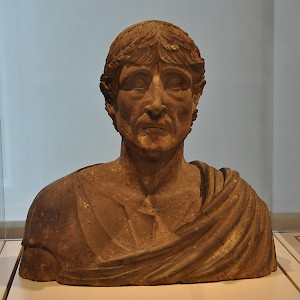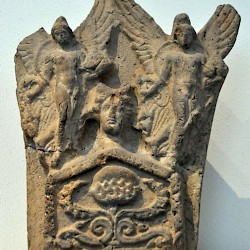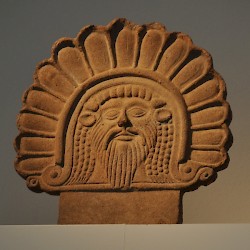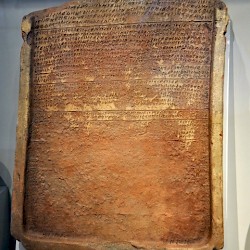This page is a stub. It will be expanded to a full-fledged article.
Capua
Q3136685Capua: important ancient city southwest of Rome, modern Santa Maria di Capua Vetere.
Origins

- Located in the plain behind Naples, now called the Campania (after Capua; the ancient connected the name "Capua" to "campus", plain)
- Ninth-century Iron Age (Oscian) settlement between the Greek towns on the coast and the Samnites in the mountains; Velleius Paterculus (who was probably born in Capua) records its foundation in 801 BCE.note
- Etruscan dynasty in the second half of the sixth century: two parts, Oscian Albana and Etruscan Seplasia
- Fifth century: Etruscan dynasts expelled after defeat against Greek forces; cf. Rome
- Cato: Capua founded 471 BCE.note This ;may refer to Greek rebuilding.
- 445 VC = c.440 BCE: The "Campanian nation was formed" note
- 424 VC = c.420 BCE: Samnites take a predominantly Etruscan citynote
Roman Republic
- 343 VC = 339/338 BCE: another group of Samnites attacks Capua, Capua ask Rome for helpnote
- c.331 BCE: Civitas sine suffragio, cf. Caerenote
- 312 VC Creation of the Via Appia; today, the ancient city can still be recognized as a 1300 meter long "kink" in this road
- Via Appia continued to Beneventum, Tarentum, and Brundisium
- 216 Hanniballic War: Capua becomes pro-Hannibal, invites himnote
- 212-211 Besieged by the Romans, who take the townnote
- The skull of what may have been Hannibal's last elephant kept in nearby sanctuary Diana Tifatanote
- 211: land becomes ager publicus; city abolished, land governed by a praefectus Capuam Cumasnote
- sII: BCE: amphitheater and theater
- In 73, seventy-eight gladiators managed to escape from the fighting school of Gnaeus Lentulus Batiatus; they were led by Spartacus.
- 59 BCE: colonia with settlers and renewed rights as a city (20,000 plebeians resettled by Julius Caesar.note
- 43 BCE: settlers sent by Mar Antonynote
- Soldiers of Caesar's legions VII and VIII, who had been settled near Capua, support Octavian
- 36 BCE: more settlers, this time by Octaviannote
Roman Empire
- In the western part of the city: forum with council house
- c.26 CE: Tiberius inaugurates a Capitolnote near curent church of Sant' Erasmo
- 91 CE Via Domitiana cuts off Capua from main road Rome-Cumae/Puteoli
- sII: Amphitheater (Hadrianic) / 165 meters long, cf.Colosseum 188) and temple Mithras
- Constantine: seat of the consularis Campaniae; builds a basilica or the apostles (=S.Pietro)
- Late fourth century: Ausonius describes the city as purely agricultural but the eighth city of the Empirenote
- 456: captured by Gaisericnote
- Flourishing in the sixth centurynote
- 594: Langobard occupation
- Modern Capua is ancient Casilinum, ancient Capua is called Santa Maria di Capua Vetere
 Capua, Head of one of the Dioscuri |
 Capua-Curti, Acroterion |
 Capua-Curti, Antefix (Silenus) |
 Capua, Etruscan Ritual Calendar |